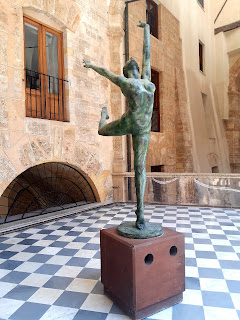Black Madonna of Tindari
 My favourite Madonna of all the
multitude of Virgin Marys venerated by the Sicilians, is the Black Madonna of
Tindari.
My favourite Madonna of all the
multitude of Virgin Marys venerated by the Sicilians, is the Black Madonna of
Tindari.
Her feast day takes place on 8 September, but the festivities go on
all weekend: these include the annual pilgrimage to her Basilica at the top of
Mount Tindari, fireworks and local processions.
 Part of the draw is the place of
her shrine: Tindari, off the beaten tourist track, sits high on a rocky
promontory with spectacular views. Founded by the Greeks in 396BC (by Dionysius
the Elder, a nasty despot from Syracuse), the ruins of the city include an
amphitheatre, the gates to the city, stone arches and tombs.
Part of the draw is the place of
her shrine: Tindari, off the beaten tourist track, sits high on a rocky
promontory with spectacular views. Founded by the Greeks in 396BC (by Dionysius
the Elder, a nasty despot from Syracuse), the ruins of the city include an
amphitheatre, the gates to the city, stone arches and tombs.
You can enjoy a
picnic there without a Japanese tourist snapping a photo of you while you munch
your sandwich (likely to happen in nearby Taormina).
But the interesting thing about the
Madonna of Tindari are the stories surrounding her origins. Legend has it that
the cedarwood statue was hidden on a cargo ship returning from the Middle East
to save it from destruction during the Iconoclastic Wars. A storm blew up and
the ship took refuge in the bay below Tindari. When the storm had passed, the
sailors lifted the anchor and started rowing but the ship didn’t budge. They
left some of the cargo on the shore, thinking that was the cause of the
problem. Still no joy. It wasn’t until they left the Black Madonna on the shore
too that the ship started to move again. Local fishermen found the statue and
decided to build a shrine one the highest point of the plateau of Tindari.
Today, Tindari draws thousands of
pilgrims and visitors every year.
Then there’s the miracle: the
legend about the beautiful sandbank below the sanctuary, in the shape of a side
profile of the Madonna and Child. The story goes that a woman brought her sick child
to the sanctuary for a blessing but upon arrival, when she saw the Madonna was
black, she refused to pray to her. The child slipped from her grip and fell
over the cliff’s edge to the sea, hundreds of metres below. But instead of
drowning, the child was found playing safely on a ridge of sand that miraculously
rose out of the sea.
Finally, you have the theories
about the Black Madonna in general, for the Madonna of Tindari is not the only
one. Prevalent in Hispanic cultures from Guadalupe to Montserrat (there’s even
one in Dublin in Whitefriar Street’s Carmelite Chapel), the mysteries of the
Black Madonna are many.
Some say she derives from a pre-Christian mother goddesss
figure, linked to Demeter or the Egyptian goddess Isis. Others say that the
dark skin tone of the Black Madonnas reflects that of the Virgin Mary, who likely
had Semitic colours and features. She is often associated with miracles, always
invoked as a protectress.
Our Black Madonna of Tindari sits
on a throne, with the child Jesus on her lap, his hand raised in blessing.
Inscribed on the base of the statue are words from the Old Testament’s Song of
Songs: Nigra sum sed Formosa (I am black but beautiful).




Wow. thank you for the amazing info. I also made an article about this: https://www.lifetimetraveller.com/holy-sanctuary-of-the-black-madonna-tindari/
ReplyDelete